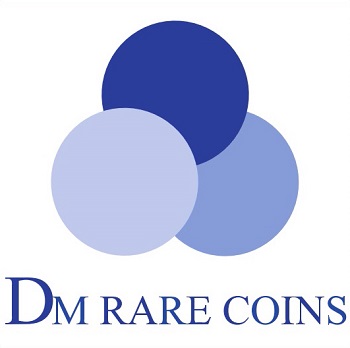You are reading an original DM Rare Coins Research Article. Find More!
December 29, 2019
From William Pitt
to Counterfeit
History, NUMISMATICS, & ATTRIBUTION Guide to the William Pitt Stamp Act Repeal Medals of 1766
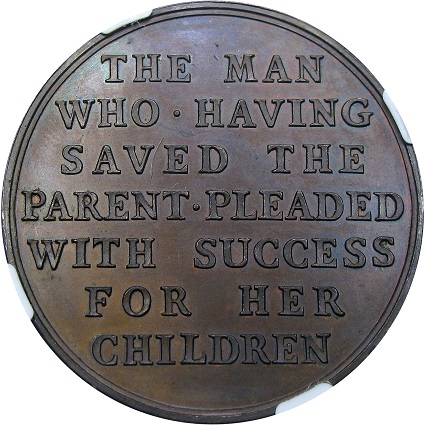
THE MAN WHO; HAVING SAVED THE PARENT;
PLEADED, WITH SUCCESS, FOR HER CHILDREN
Turmoil
The year was 1765, and the American colonies were facing a barrage of new taxes levied against them to pay for the French and Indian War. The expensive conflict effectively ran from 1754-1764, if one is to count the Indian wars that continued beyond the Treaty of Paris. Early on, Britain suffered one defeat after another and nearly lost the Great Lakes region and the Ohio Valley to France; but for William Pitt’s intervention in 1758. As Minister of War for George II, Pitt initiated a global strategy that cut French supply lines globally, and opened the way for swift conquest of the American continental interior.
In addition to the French and Indian War, the global conflict ultimately became known as The War for Empire; and in the European theater, it was the Seven Years War. When Pitt’s management delivered a string of monumental victories, around the world, in both 1758 and 1759; and saw the French utterly driven from Canada, with the fall of Montreal in 1760; Pitt became a living legend in the English-speaking realm. By the end of the conflict, British military superiority had been established, and the small British Isles were reaffirmed as a global empire. Pitt was thereafter known as the Great Commoner. Ironically Pitt was forced to resign in 1761, shortly after the succession of Hanoverian George III, following his suggestion that an attack on Germany would be beneficial. Pitt would, however, remain an influential member of Parliament.
The war, which had started in America (by George Washington, in fact) would also end in America, with the defeat of Pontiac’s Rebellion in 1764; and the British intended that their stubborn colonies, who barely contributed monetarily to the war effort, would be made to show respect to the mother country and pay for their defense (Anderson). The Stamp Act of 1765 was the most onerous of these measures. However, not everyone in England agreed with this rationale. The man who; having restored British influence; now turned his attention toward British subjects in the colonies, whom he felt were dealt an unfair hand with onerous taxes without representation. On January 14, 1766, Pitt delivered a moving address to Parliament, known as “In Defense of the Colonies,” pleading that the mother country should relieve her children of these unfair burdens. Pitt argued that “the greater must rule the less. But she must so rule it as not to contradict the fundamental principles that are common to both” (Pitt). Pitt's Whig party was enamored by him, and the text of Pitt’s address made its way across the Atlantic and was met with great fanfare in America. Pitt immediately and successfully created a shift in public sentiment, and the Stamp Act was repealed in March. This solidified William Pitt’s stature as a beloved British icon, on both sides of the pond.
Exultation & Scorn
Considering there was a Royal Society devoted to medal making in the mid-18th century; The Society Promoting Arts and Commerce, or SPAC; it should not surprise us today that the British struck many tokens and medals to commemorate the occasion. In addition to numerous low-quality tokens produced for the general public, in the vein of the notoriously shoddy Vernon medals, a fine and stately medal was also engraved for the aristocracy. Medals struck from finely engraved dies were the height of technology in the 18th century and could be powerful messaging tools to reach both political and personal ends. Eimer concludes that Thomas Pingo's engraving shop received their commission to engrave and strike the William Pitt Stamp Act Repeal medals of 1766 from London 'toyman,' John Kentish (Eimer, Pingo, 23). Some have speculated that SPAC benefactor, Thomas Hollis, may also have had a hand in it. Hollis was not just "a notable eccentric," but also an "Old Whig" and "staunch dissenter" to the king, deeply sympathetic to the difficulties and aspirations of the colonists," and someone who obviously regarded Pitt as one of his top idols (Bond, 77, 80-81). He preferred to work behind the scenes, fervently asserting his passions in letters, and then asking their recipients burn after reading. Since 1758, Hollis had regularly requested that SPAC sponsored medals regarding the war victories be engraved on their edges, "WILLIAM PITT ADMINISTRING," and presented to the man. When the Stamp Act Repeal medals came out in May of 1766, Hollis sent some of them to his friends in America, and they were certainly of the understanding that he had designed them (Bond, 91).
Regardless, the predominant British engraving firm of the mid-18th century was on the case. The result was an exceptional, high-relief sculpture of William Pitt adorning the obverse, his name Latinized around the margins, “GVLIELMVS PITT.” The reverse bore only an English inscription: one that perfectly captured the sentimentality of the day. It was succinct, almost to a fault, “THE MAN WHO, HAVING SAVED THE PARENT, PLEADED WITH SUCCESS FOR HER CHILDREN.” This may have been one of Thomas Hollis' witty lines.
Just a couple months after the medals came out, Pitt accepted a role in the government under George III, as Prime Minister, and peerage as First Earl of Chatham. Because it was widely believed the King was compromised by the Tory party, lead by John Stuart, Earl of Bute, the Whigs promptly turned against Pitt and accused him of backroom dealing with the enemy. It became widely assumed and feared that Pitt had been conspiring behind their backs all along. Even Thomas Hollis made his displeasure known and broke tied with The Great Commoner. Hollis' friends in America shared the same sentiments in their correspondence, indicating a swift change in his popularity was international. According to the editor of Hollis' letters, “the communication of news and ideas between two continents was slow by modern standards, but it was real, it was efficient, and perhaps more rapid than many realize today" (Bond, 83).
For several years, Pitt was on the outs with his party, until it became clear he had not sought to undermine them after all. And finally, in 1778, a decrepit and ailing Pitt came out of retirement to orate on the floor of Parliament, one final time. He argued in favor of America's rights during the American Revolution, and he collapsed and died, sealing his good reputation once and for all and proving that he was a man of honor and that his mistakes were in earnest. Put succinctly, "in an age of bribery Pitt could never be bribed. He made mistakes, and sometimes, like everything else in his career, they were on a colossal scale, and if he had died ten or twelve years earlier the verdict of history on his career as a whole would have been quite other than it rightly is today" (Reid).
Numismatics
Today, these relics of the 18th century Stamp Act are important pieces of American colonial history that should be collected alongside the wildly popular 1766 William Pitt tokens. The Pingo medal was first advertised in England, but its popularity quickly crossed the Atlantic, where it was also advertised and sold to Americans. The predominant 19th century authority on these medals, C. W. Betts, in his American Colonial History Illustrated by Contemporary Medals, of course, included the Pitt medals in his work. In fact, because they deal not only with an American subject, but were also distributed in America, these medals are of particular significance, and should be sought by every Colonial collector. They were so special that both copies and counterfeits were issued at various points in time. However, much confusion has been created around them, largely because of these variations.
Great confusion persists partly because of the vague entries in Betts. He was apparently unaware of any reproductions when he added the Pitt medals to his groundbreaking catalog, which, in fairness, was published by the editors, upon his death, in 1894. Thus, we will say that the laissez faire treatment of this medal in the Betts book, with missing varieties and a seeming ignorance of the reproductions, has led to many misinterpretations of the catalog. Our research has identified five die varieties of various, and even mysterious, origin. Betts offered only two catalog numbers, 515 and 516, and these numbers do match two specific die pairs, and no others. However, catalogers are constantly trying to make the other varieties match Betts numbers; but they simply do not, and never will. For instance, the most common offense is to assign Betts 515 to all varieties without a signature, and 516 to all varieties with a signature. This is an oversimplification of the reference. Some will even classify 516 as a reproduction or restrike, simply because it is placed after Betts 515 in the catalog. This is an egregious offense, considering Betts did not know of one.
The British Historical Medals and Eimer references are no more clear. In the former catalog, all versions of Pingo's Pitt medal fall under the catalog number BHM-100 (Brown, 24). We have come across second-hand references suggesting that Eimer has broken these medals down into die varieties, but we have not been able to find a published listing of these numbers. Additionally, our interpretations seem to be different than what we know about his. Eimer’s British Contemporary Medals and his Pingo Family book only mention the existence of “several minor varieties” (Eimer, Pingo, 55). More detail than that is needed because not all of these variants are original.
Variety Attribution
Creating an effective attribution guide requires a rudimentary die variety analysis. We have accomplished this over a period of more than a decade, through the examination of numerous auction descriptions and images, as well as the examination of high-grade examples of these medals, in-hand. We have determined there to be four distinct die pairs, with no interchanging of obverses and reverses known between them. Hence the use of Die Pair 1 through 4; it is unnecessary to break down obverse dies and reverse dies separately, such as Obverse 1, Reverse A, Obverse 2, Reverse B, etc.
We argue that the existence of four varieties cannot be questioned, but it is the exact origin of some that remains in the realm of educated speculation. It is our opinion that two separate die pairs were employed in the striking of the originally commissioned, 1766 Pingo medal, and that two die pairs were created to make copies, or even counterfeits. Two dies are clearly of 18th century manufacture and are actually signed by the engraver, while two dies are of later manufacture and are unsigned. The questions that cannot be answered with certainty are: in what period were the reproductions made, and by whom?
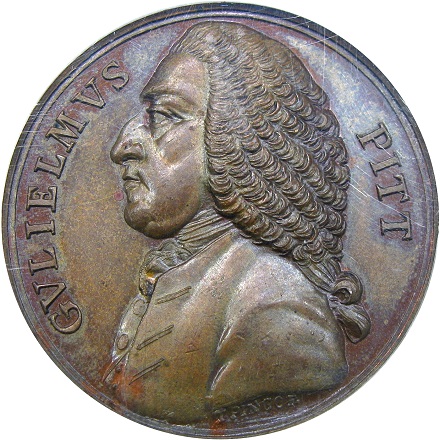
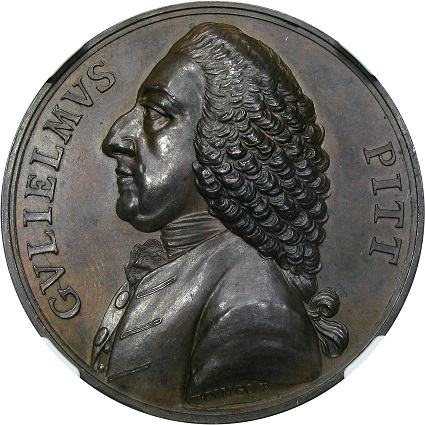
The two signed obverse dies.
Two obverse dies were signed “T. PINGO F.” beneath the bust. The greater body of evidence suggests these were the dies used in the striking of the original, 1766 medals. These die pairs have slight differences in design, which become very noticeable when compared side by side. It is our belief that the original Pingo design, almost certainly a prototype, can be discerned by its more detailed portrait and exquisitely rendered, high-relief, fine details. Every detail is hand-engraved on this large, honest portrait of Pitt. However, it depicts an old, bloated, overweight man with sagging jawline and beady eyes. His humongous head dominates the canvas, leaves little room for the lettering, and is seated atop broad shoulders which seem to eliminate the need for any neck, his muddled cravat fitting very closely against his chins. It might not be flattering, but the detail is magnificent. The bust is wider, fuller, and in a higher relief than on the other signed obverse, and the hair is much more intricately detailed than on any other die. This variety is clearly defined by Betts as number 516, in that "the wig is fuller and the letters heavier" than on his 515 (Betts, 229).
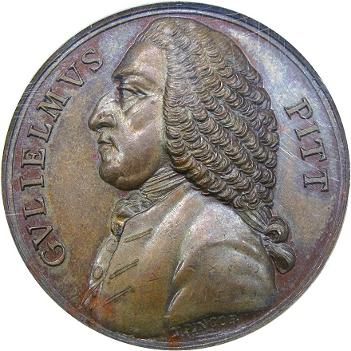
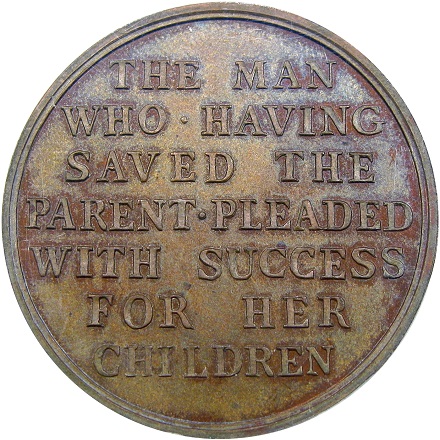
Die Pair 1, NGC MS64
The dies were prepared with frosted devices and Prooflike fields, as seen on the earliest impressions in silver. The rims are prepared with sophistication, decorative shelf made from spinning lathe lines around the perimeter, terminates at the true rim, with a crisp, flat edge from striking in a close collar. The lettering is engraved as neatly as possible from hand-made, imperfect letter punches. The letters "GVL" are more closely spaced than the “IELMVS,” suggesting the engraver had to rethink the spacing, in the middle of the word, in order to make it fit properly into the margin. There was also re-cutting on several letters, particularly the "MV." A number of the reverse letters are double punched, and it is clear that the tail of the decorative “R” punch had to be trimmed off to make the words “PARENT” and "CHILDREN" without having any overlap between “R” and “E.” There are two raised spacer dots on the reverse, the first being of irregular shape, the second being round, and both being high-relief and bulbous.
Further intriguing anomalies are that the "T. PINGO F." signature is warped by die rust, acid etching, and polishing, making it wavy, and the nearby curving line truncating of the bust is largely polished away. Many fine die lines show on the bust as well, an attempt to remove die rust. The die also appears to be unfinished; the bridge of the nose shows engraving lines that suggest the engraver cut too deeply, not leaving proper relief to flesh out the nose. The button loops are also unfinished on their right sides. While this die is exquisitely detailed and it undoubtedly produced the most intricately engraved, breathtaking medals of this entire issue, it nevertheless had some eccentricities when viewed under magnification It is possible the engraver initially shelved this die in favor of another design.
We believe it is because of these problems that the second die pair was created, and possibly before pieces were struck from the first. Of the various engraving anomalies found on Die Pair 1, the most pressing concern would have been the unflattering portrait of Pitt and the incomplete profile. The engraving of the second die pair corrected the various errors of the first by shrinking the bust, developing more stylized portrait of the Great Commoner, and correcting the errors of the previous attempt.
Pitt is no longer glaring, nor do his plump cheeks interfere with the sleek lines of his profile. A dimple has been added to his cheek, just behind the mouth. Pingo also tightened up the cravat; organizing the folds symmetrically and adding more details to the fabric; all the while pulling it away from the chin and collar to show that Mr. Pitt really does have a neck. Indeed, Pitt has undertaken a serious diet program for this portrait; his smaller bust and profile now decidedly stately and his wig restyled to accomplish similar effects with fewer curls. The same engraver seems to have been systematically correcting the mistakes of the first die pair, though he made some of the same mistakes again. Re-cutting and repositioning is seen on the "M" in "GVLIELMVS" again; and another web of engraving lines are found on the nose, where Pingo started in to deeply again, but this time caught himself, and the nose could still be finished in relief. Again, the dies were prepared with frosty devices, mirrored fields, and a lathed edge leading to the true rim and flat edge.


Die Pair 2, NGC MS64
With a smaller bust came a change in the relief of the design. On Die Pair 2, the highest relief is now sloping very noticeably away from the hair curls above the ear, whereas Obverse 1 shows a much more gradual slope. This smaller bust has shrunken Pitt’s shoulder, below which the “T. PINGO F.” is engraved smaller, and the thin, graceful, curving line at the truncation of the bust is intact. The major lettering punches are still hand-made and of similar style, but are done in a slightly smaller font. A smaller head also meant more room to work, and the lettering has been punched more neatly.
On the reverse, the engraver also benefited from smaller lettering, eliminating the need to curtail certain letters to make them fit together into words. The letters are somewhat more exactingly placed, save for the last “S” in “SUCCESS,” which is punched noticeably high. The globular spacer dots, this time, are both in the round and in strong relief, though very small. Again, this hand-engraved die was done with similar style and almost certainly accomplished by the same hand, doubtlessly one of the Pingos. Someone was clearly correcting their prior mistakes.
The Pingos had now streamlined the medal. This redesign would have pleased William Pitt, who must have seen these famous creations. With the new design also came the ability to strike on lighter planchets, and likewise, the weight was reduced from around 37 grams for bronze for Die Pair 1 medals, to around 22 to 24 grams, for bronze Die Pair 2 medals. A lighter medal is easier to strike, and ease of production would have been a prime consideration for a medal that had recently gone international. A diary reference to a specific example from this die pair, in October of 1766, proves that Die Pair 2 is original (Eimer, 55). It was probably intended to be the main working pair and, interestingly, it appears that about three quarters of silver strikes are from these dies. Strangely, there is no direct mention of Die Pair 2 in Betts. Often categorized as Betts 516 because the obverse die bares a signature, it lacks the fuller, more detailed wig specified by Betts.
This type of design revision was not uncommon on medals of the period. For instance, an unflattering George II portrait on the Victories of 1758 medal attributed to John Kirk, Betts 416, was quickly revised in a similar manner. The engraver successfully turned a scowl into a smile, and cleaning up the hairdo. In that instance, they were at risk of insulting the King.
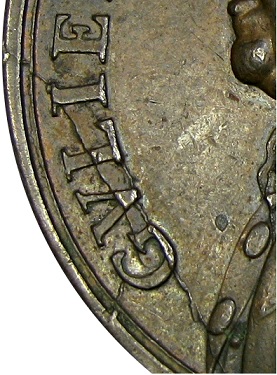
Unfortunately, Die Pair 2 was not to last. An unsightly series of progressive obverse die breaks lead to this die’s premature retirement. Some numismatists have even reported examples showing tooling, where an attempt was made to remove the unsightly cracks from the finished medals, likely at the time of manufacture.
While this sounds barbaric, it was yet another common solution to a common problem. In 2006, Stacks sold a number of the Pingos' 1759 Quebec Taken medals, on which a large obverse rim cud in the collar margin had been filed down to match the height of the rest of the rim. Eventually, they moved those dies into a new collar, solving the problem altogether, but many medals were issued with aggressively filed rims.
However, in the case of the 1766 medal, the break was on the die face, and the only solution was to scrap the die. It is intriguing that there does not appear to be any intermingling between Die Pairs 1 and 2; it might have been feasible to pair Obverse 1 with Reverse 2 at this point, creating a new variety. That didn't happen. This may further strengthen the idea that Die Pair 1 was rejected on artistic and not practical grounds, or that they were used at different times.
We have noticed is that all examples of Die Pair 1 show die rust on the lower obverse, as well as in the reverse lettering. Could the dies have shelved for a time, allowed to rust in storage, but then resurrected after the untimely failure of number 2? This is an intriguing possibility, though we caution, die rust was a common occurrence on 18th century coins and medals, and it is dangerous to read too much into that by itself.
Also, there are examples of Die Pair 1 struck on lighter planchets, consistent with those used on Die Pair 2. It is possible that Die Pair 1 actually was used first. The sample we studied was about 21 grams, bronze, instead of the usual 37 grams. While were clearly of the same manufacture as the heavier pieces, we noted a slightly later die state on the 21 gram piece, with even more obverse rust and a meandering die crack down the reverse. It could be that, by the time it advanced to the later stage, the new design and planchets were ready and some pieces from Die Pair 1 got struck on the new, lighter planchets. The Pingo's may have had both dies going at once, in fact. This light weight Die Pair 1 is interesting enough, both in size and diagnostics, to be given a separate designation, DMRC-1A.
It is also worth speculating that the Pingo's may have abandoned Obverse 1, altogether, allowing another engraver, or perhaps even an apprentice, to finish the dies and hurriedly get the medals into the market at the height of their demand. This theory could have some merit. There does seem to be a mismatch of letter punches; for instance, the "S" on the obverse is very similar to Pingo "S" punch we've studied, while those on the reverse almost seem hand-engraved. That said, the same the "E" punch is used on both sides, and it could be die polishing that is to blame for the mis-shappen letters.
It should be understood that, despite the talk of engraving flaws herein, these defects are minuscule. The finished medals from both Die Pairs 1 and 2 are of superb quality, with sharp, high-relief detail, contrasting motifs, and finished rims and edges. If this obverse was sold off, perhaps the only engraver in London capable of producing such a product on par with the Pingos was John Kirk. The Pingos did sometimes trade ideas with the Kirks, as both families were involved in the Society Promoting Arts and Commerce. Kirk once adopted a very close version of Pingo's Louisburg Taken medal in 1759. More notably, Kirk used the famous 1760 Pingo accession bust of George III to make several of his own medals. A study of Kirk letter punches would be an interesting endeavor, regardless of outcome.
Ultimately, whatever the exact order of production, it is important to note that the medals of Die Pairs 1 and 2 consistently retain all the manufacturing characteristics of quality, 18th century techniques. The possibilities involving Die Pair 1 are interesting, but of limited significance. The obverse is signed by Pingo, and the bust appears to be cut by the same engraver who cut Obverse 2. Whether Pingo, or perhaps Kirk, put on the finishing touches and employed the screw press seems secondary. Forensically, what we can say for certain is that both die pairs produced fabulous medals, and importantly, both die pairs failed.
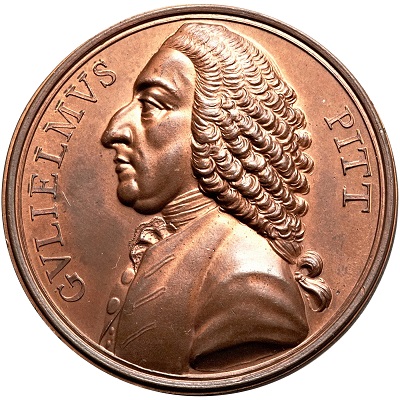
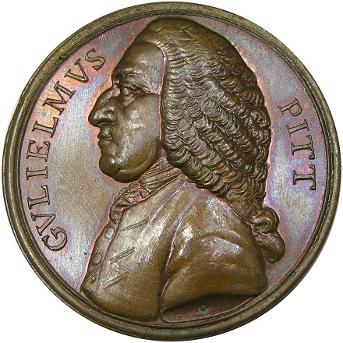
The two unsigned obverse dies.
Mystery
What happened next remains a mystery. At some point, a third die pair was created; beyond that is speculation. The dies were clearly at the hand of a new engraver; in fact, the obverse die was actually left unsigned, which is typical of many august copies. There are also major quality inconsistencies that indicate that Die Pair 3 is a copy and not an original Pingo medal. These factors include the use of a transfer process to create the bust; new and uniformly machined letter punches; a new surface finish; a new collar and rims; and what can only be described as a gross inattention to planchet size.
Die Pair 3 should technically be called a “copy” rather than a “restrike.” It was likely produced by someone imitating the originals, but with newly created dies and different standards of production. The period of time from which these creations hale remains unclear, but the prevalence of high-grade pieces, some that would even designate Red & Brown, has been pointed to as an indication of a younger age. That said, we have also seen well-worn examples of this variety. Also, these seem to appear frequently in UK auctions, which is circumstantial evidence that they were made in England.
Factually, we know these existed in 1894 because Die Pair 3 is the only exact match to Betts 515. It shows a copy of the small bust of Die Pair 2, but with much thinner lettering, and no signature. Betts made no mention of it being a reproduction and he must not have known, as it was placed ahead of 516 (our Die Pair 1), a signed version. Cataloging this copy sequentially before a known original has created much confusion.

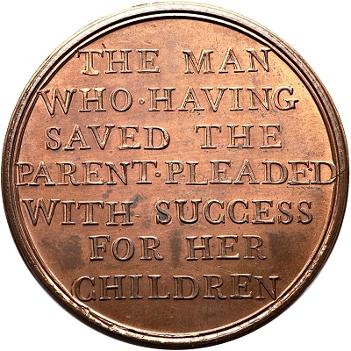
Die Pair 3, Red & Brown Uncirculated
Clues to its origin might be found in how the dies compare to those signed by the Pingo family. First, the portrait, and only the portrait, was rendered through a transfer copy of the small bust first used on Die Pair 2. It is tempting to think that an original "puncheon" of the Pitt bust may have been used, as the portrait is quite faithfully impressed. Eimer notes that all of the original Pingo dies, punches, and the like, were sold off by the Pingo estate in 1792, just 26 years later (Eimer, Pingo, 20-26). However, we do not know if a puncheon was created. Suffice it to say that somehow, the engraver of Die Pair 3 was able to make a very close copy of the bust. It does have the tell-tale appearance of a transfer copy, faithfully reproducing the major design elements, but missing the hand-engraved appearance of the original dies. Instead it has a homogeneous surface that looks molded rather than engraved.
In fact, these copy medals tend to have a uniformly glossy or even satiny finish across the entire surface, with little contrast between fields and devices, except for evidence of frequent, almost continual polishing. This is completely unlike the known originals, which were carefully prepared with frosty devices and mirrored fields. In fact, the original, 1766 dies maintained at least a trace of contrast for their entire production life and do not seem to have been refinished in this way.
In addition to differences in the creation of the bust and the finish of the surfaces, the letter punches are altogether inconsistent with the originals. We have already spoken at great length about letters; Pingo letter punches were hand-made, in house. The making of engraving punches was a part of their business, and their punches display various quirks and imperfections in shape, size, and style (ibid., 25). The letters on Die Pairs 1 and 2 varied slightly but were both thick and sturdy in their construction, and they showed bulky, triangular serifs, the the exception of the E on Die Pair 1, which had a broken middle serif.
In contrast, the Die Pair 3 letters appear machine-made, with symmetrical curves and sleek, slender lines and serifs. They seem too perfect. In fact, of the 124 Pingo medals illustrated by Eimer in The Pingo Family, we do not see any that match the new font on Die Pair 3. They are taller, thinner, scant, and frankly, ill-suited to execute this verbose medal design. The overall font size turned out to be a little too big to fit. Several of the letters; most noticeably the aforementioned "W," the "P" in "PARENT" and the second “D” in “PLEADED;” run off the field and through the rim, breaking the ring around the reverse in several places and creating a very sloppy result. The engraver actually found it necessary to bend the rims around the "D" and other letters. Surely this was not the work of the Pingos, who were filling an order for a paying customer. The letters on the Pingo reverse dies were kept far away from the circle around the periphery.
Perhaps more telling than the difference in font style was the spacing of the new letters. On both original die pairs, we see an attempt to make imperfect, hand-made letter punches run smoothly, in seven straight lines, across the reverse. In contrast, on Die Pair 3 we see an attempt to stagger uniformly machined letters, in noticeably crooked lines, to forge the appearance of old-world craftsmanship.

Letters "W" and "P" crash into the circle around the periphery. Note the over-sized "W" punch, and the crumbling rim below "C."
It appears that the "E" punch may have been crafted with a doubled image, as most appearances of the letter show the same re-punched base. Other eccentricities include the extra-large “W” punch. One will also notice the difference in spacer dots, which are now large, round, dimpled swirls; rather than small, hand-cut, spherical domes. These features look more modern than those found on the originals. Finally, a die crack developed fairly early, through the last “D” in "PLEADED," and the die face started to crumble around the bottom in later stages.
Since we have recently bumped into them, we must address the rims on the copy medals in due fashion, as they are often ignored, but indicate a much less sophisticated method of manufacture. Actually, we have found no written references to the rims of any of the dies. The rim preparations are identical on Die Pairs 1 and 2, and care was taken to craft an attractive, finished product that would be respectable and worthy of saving. Die Pair 3 shows the exact opposite attention to detail. These reproductions distinctly show a plain line encircling the perimeter, instead of a lathe line self, and a very thick rim that shows a seem, i. e., evidence that an old rim has been merged into a new one. Beyond this thick rim is a margin of squeezed metal, as these were apparently struck in an open collar, creating an irregular shape to the medals and a rounded edge. The planchets being used were also too wide, creating further problems with excess margins that took the diameter consistently out to over 41mm, instead of the 40.0mm to 40.3 mm diameter of the originals. These copies are truly unfinished. There is even evidence that the merged rims began to separate, allowing metal to squeeze through during striking and creating a round surface around the rims.
Clearly, these inconsistencies demonstrate not only a new style of die preparation, but a deficient one that was accomplished with less sophisticated machinery. We have seen one piece in silver that appeared to have the correct planchet size. If this piece proves to be truck in-collar, it could have been made earlier, and parhaps Die Pair 3 was actually copying that emission. If the rims were copied and merged with a new rim, they had to be copied from somewhere. A metallurgic analysis of the various medals It would be interesting, across the board.
With the rare exception, the medals of Die Pair 3 are deficient reproductions of the original Pingo medals. The best thing these copies have going for them is that the bronze pieces are often found with considerable mint red color. This makes them very attractive, but is another circumstantial bit of evidence supporting a much younger age. And, let us not forget that the engraver’s signature was intentionally omitted. Perhaps no one wanted to take credit for this sloppy creation, or was it left out because the creator was intending to deceive?
Top: Die Pairs 1 and 2 show characteristic ring, rim, and flat edge of many Pingo medals.
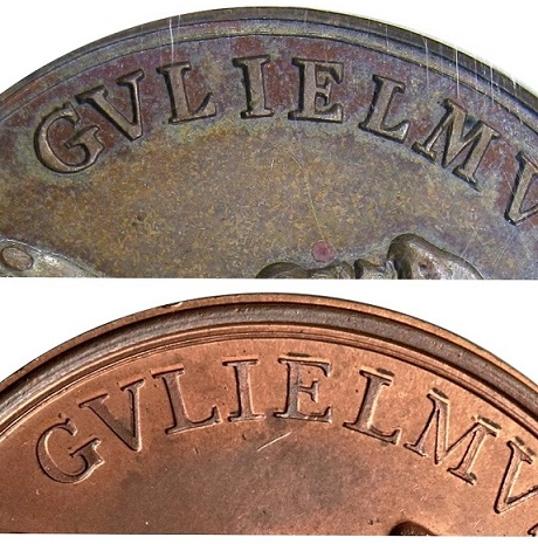
Bottom: Die Pair 3 shows ring, original rim merged with new rim, and margin of excess medal with a squeezed, rounded edge.
The question remains, when were these copies produced? Some have suggested that Die Pair 3 was an 18th century contemporary copy made by someone other than the Pingos. Perhaps it was cheapened in order to satisfy demand in America after the Pingo dies broke. We have been down that road already. Maybe it was even re-struck with new dies by the Pingo's when they became masters of the Royal Mint. These things are certainly possible, but they do not seem likely, based on the intentionally deceptive workmanship of this copycat issue. It could also be a product of the early 19th century, when the Pingo punches and dies were disbursed. Again, a metallurgic analysis could provide scientific evidence to strengthen one theory or another. It is worth noting, too, that the famous (infamous) engraver, “I.W.,” filled the role of copycat in the 1760s, with his own brass version of the Pingo medal (Adams & Chao, 47, 209). However, his pieces are not part of our study, as they were cast in brass, not struck in bronze and silver. They were also slightly smaller than the authentic pieces, and they were clearly signed “I.W” below the bust. This copycat coiner was not afraid to sign his work.
Intrigue
Perhaps the answer to the riddle of who made Die Pair 3 was given to us, all the way back in 1901. That year, Mr. Edward Groh wrote a letter, to be read before the American Numismatic & Archaeological Society of New York City, on a counterfeiting operation he stumbled upon by accident, some years prior. The year was 1863, and Groh had been interested in acquiring the Civil War tokens being struck in great numbers during the token boom that year. Walking into a shop at 29 Rose Street, he was surprised to find before him a large screw press, on which sat a trial strike of the Pingos' William Pitt medal. Groh picked it up with intrigue, but the German shopkeeper took it away from him “hastily.” Groh was already beyond suspicious, and politely asked if he could purchase one of these medals from the German. The shopkeeper answered him in the negative, insisting that the dies did not belong to him, and because he did not want to upset the owner, who was "a very good customer," he simply could oblige. Groh didascertained that the engraving had been done “by a die-sinker of [New York] city” who wanted it kept secret. Eventually, over the next few days, Groh cajoled the shopkeeper into having a piece struck for him on an old silver crown of Charles II, which Groh provided for the occasion. Upon delivery of this over-strike, Groh was also given a piece struck in white metal; perhaps to satisfy him and to keep him quiet. That seems to have worked, as he apparently waited some 38 years to publicize the event in his letter.
Fortunately for Numismatics, Groh still had the counterfeits when he wrote in 1901. Yet, the huge time lapse could have allowed the operation to grow and mature unabated; Groh certainly thought so. He speculated, in his letter, that there could be “no doubt” that “a number of these medals have found their way into the cabinets of Numismatists throughout the country, as well as in this city, who may be deluded with the belief that they possess the original English medal.” Having already noted that the counterfeit he received “answers precisely to [Betts’] description” of number 515, he went a step further, suggesting “it is possible that Mr. Betts may have been deceived with the imitation and placed it on the record as a variety of the original.” The only elaboration Betts made about 515 was that there are “two varieties with slight differences, in bronze” (Betts 229). Groh is certainly correct that, if Betts had even an inkling that a copy was on the market (Die Pair 3), he would have mentioned it, and he would not have placed it ahead of an original, Die Pair 1, and fail to mention Die Pair 2 altogether (Groh, 68-69).
This is positively damning information. However, the 1863 counterfeit theory is not quite air tight. Mr. Groh’s medal, struck over a Charles II crown, miraculously survives today, as do some of the other pieces from his account. Stacks sold the over-strike in 2006, along with a double struck piece in silver, and a flip-over double strike in white metal. An additional piece, in silver, was auctioned by Heritage in January of 2014, with a note referencing Mr. Groh’s 1863 encounter and stating that this piece was of that same origin. This one was struck on an extra-wide, 43mm planchet and is probably the die trial Groh found in the shop.
With these pieces surviving, researches have tried to determine which dies they employed. This has proven extremely difficult because of the incompleteness of the surviving pieces, all of which were either worn, weakly struck, double-struck, or over-struck. At first glance, the dies look like some sort of advanced stages of Obverse 1 and Reverse 3, though the signature has been removed and there are some other puzzling differences.
Breakthrough
The original publication of this article in December, 2019, stirred up the dust of history just one month later, to reveal a new discovery, previously unknown example from the Groh dies in bronze. Not only is this a new composition, but it is well-struck on a virgin planchet. Even more remarkably, it survives in Choice Mint State and is from an earlier die state than those associated with the Groh account. As currently the only normal strike example that we have documented, this enigmatic piece has proven invaluable to this examination due to its detail and condition. And, its existence is the first indication that more pieces were produced, beyond the realm of Groh's encounter in that clandestine, NYC shop in 1863. Then again, we've only found one.
With a sharp, uncirculated, confirmed 1863 New York piece, unable to hide its secrets behind flat strike or wear; the upshot is that it's not what we thought. The Groh medals are not struck from Obverse 1 or Reverse 3; the dies themselves were cast counterfeits, and crude ones, at that. And, Mr. Groh, it technically does not match Betts 515, either. Like many numismatists, Groh incorreclty Betts, assuming that the unsigned obverse die automatically indicated Betts 515, apparently not realizing that this counterfeit features the large bust seen on Betts 516. It there fore matches neither number. Remember, Betts numbers only precisely match two of the four known varieties.
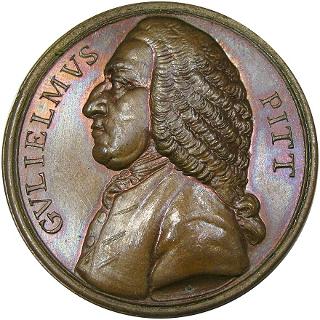
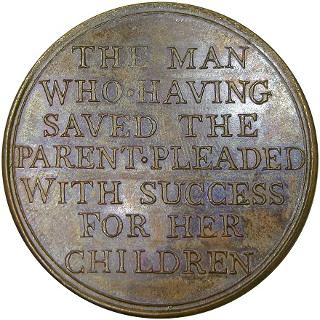
Die Pair 4, NGC MS64
We catalog the Groh variety as Die Pair 4, and classify it as a forgery. These dies were made in secret, from casts of struck medals, and, apparently, with the intention to deceive. From this amazing study piece, we were able to learn a great deal of information about the manufacturing of this variety.
For instance, the dies themselves were cast counterfeits, and the transference was crude. Peculiarities such as the familiar spacing of “GVL,” confirm that we are looking at a complete casting of Obverse 1, not just a copy of the bust, as we saw with the creation of Obverse 3. Yet, the details did not transfer as neatly as they did on Obverse 3. We know this is a new obverse die, and not a late die state of Obverse 1, because the counterfeit die posses details that were not present on the originals, lacks details found on the original, and lacks the characteristics of hand-engraving, except where alterations were made.
Again, the nose on Obverse 1 was unfinished. It is fully defined on Obverse 4. The truncation of the bust was largely incomplete on Obverse 1 due to polishing and die rust. It is fully completed, in strong relief, of Obverse 4. In fact, it looks as though it was sculpted into place, with fresh engraving lines smoothing and connecting it to the shoulder. Finally, the spun shelf leading to the true rim on Obverse 1 has been replaced by a rounded, raised, decorative line, and an extra thick rim that leads to a margin of squeezed metal and an oversized planchet. This should sound familiar. The diameter of the sole known bronze piece is 41.8mm, well over the 40mm diameter of the dies, and it shows an extra margin outside the rim. In fact, all examples of Die Pair 4 vary in diameter but show an extra wide margin and appear unfinished at the rims. This reminds us of Die Pair 3, but even more pronounced.
There is more. Also, the new die is missing the extensive die rust features that were found below the bust on Obverse 1. Remember, these numerous, raised lumps on the medals would have been deep cavities on the pitted die face. Obverse 4 shows no trace of these lumps, and the position of the bust in relation to the new rim ring does not provide space for the type of extreme work that would have been required to erase these defects from the old die. In fact, where we should have lost detail to extreme polishing on the coat, we actually see enhanced detail. The evidence suggests that the lumps were polished off the struck medal that the forger used to make the cast. This is likely also when the signature was removed. The series of die lines under the bust and around the coat appear to be distorted by the casting process, which means they were present on the host medal when it was cast. Further, these lines also blend into the homogeneous surface finish because they were hand etched on the host medal, but cast into the counterfeit die.
In addition to physical differences in the design itself, the tell-tale signs of a cast die are present, and we can see that it was a rather crude attempt. Grainy texture and defect lumps always form, to some degree, on a cast. These will be particularly problematic around fine details. The fine lines of the coat are grainy and lumpy. Further, the poorly molded wig curls, as well as the braids in the queue, show substantially less detail and lack the hand-engraved appearance of Obverse 1. In fact, several extra hair lines were hand-cut into the cast die, in an attempt to strengthen poorly molded curls. These features really stand out from the homogeneous, molded appearance of the rest of the bust, especially considering they are not present on the original design. The forger also moved the second "T" in "PITT" upwards, correcting a slight tilt seen on Obverse 1.
The surfaces have been aggressively filed and lapped to remove the lumps and bumps of casting, which hit the lettering extra hard, making them wavy, thin, and very jagged. Ironical, this makes them seem a little more like a true Betts 515, i.e., thinner letters. The faces of the letters show obvious graininess where the forger could not reach into the recesses of the dies to polish away the grit. Other features were lost to lapping, like the border on the cravat. Some of these things are difficult or impossible to see on the worn and over-struck examples of this variety, so the MS64 sample has proven invaluable.
The extra large "W" punches and the generally similar spacing on Reverse 4 both indicate a close relationship to Reverse 3. But, as we saw with Obverse 4, Reverse 4 is also a cast counterfeit die. Reverse 3 developed a crisp die break through the "D" in "PLEADED," and it is nowhere to be found on Reverse 4. This confirms beyond any doubt that we are looking at a new die. Neither is there any trace of the crumbled lower die, seen on Reverse 3. Instead, the lower portion of Reverse 4 is absolutely crisp and new.
Reverse 4 uses a rounded ring around the periphery, just like that seen on Reverse 3, and now Obverse 4. However, close examination reveals that forger actually re-positioned the ring on Reverse 4. Yes, even the forger managed to get all the text to fit inside the line, though he did leave a few traces of the old ring in places. There is actually a chunk of the old rim attached to the last "D" in "PLEADED" that carried over during casting. You will recall those features were wedded together on Reverse 3.
The forger was very good at tinkering. In addition to new rims, he changed the dimpled swirl spacer dots into raised domes, much like like those on Reverses 2, but larger. The letters of Reverse 4 were filed even more aggressively than on Obverse 4. An interesting observations can be made by looking at the word "PLEADED." The "L" leans sharply to the left on Reverse 4, where it leans slightly right on Reverse 3. The extensive tooling to remove casting lumps actually filed away enough of the "L" to make it lean a different direction. Some of the re-cut letters found on Reverse 3 were also erase. One of several instanced of defects that were not polished away is the blob forming a spike on the last "S" in "SUCCESS." Interestingly, even though there just a few pieces known from these dies, there is evidence that he performed additional filing to reduce some of these features on later strikes. Die Pair 3, or Betts 515, was the die with the narrow lettering. The forger whittled those down on Reverse 4 to the point they seem positively skeletal.
Another interesting observation about our Die Pair 4 sample: this piece was likely struck on a cast planchet, unlike the rolled and cut planchets of the Pingo medals. There is a great deal of porosity in the metal that goes beyond the granularity of the cast dies. Therefore, Die Pair 4 is a die-struck medal produced using cast dies and cast planchets; an interesting thought. This forger was clearly not aiming for quality. Problems with strike pressure were also apparent on most examples, save for our study piece. He simply may not have had the right equipment to produce a crown-sized, high-relief medal.
One additional surprise is that Die Pair 4 seems to be very rare. Until the recent appearance of our all-important bronze study piece, we had not documented any examples that were not directly related to the Edward Groh account or the 2006 Stacks sale. This makes for a puzzling quandary: if the counterfeiting did continue for many years, where are the medals?
Reflection
It is tempting to read Groh’s letter and think that his Die Pair 4 was an early creation of a counterfeiter that went on to produce numerous, more sophisticated counterfeits, such as Die Pair 3, over nearly four decades in which he remained hidden. Yet, there does not seem to be any direct evidence that Die Pair 3 and Die Pair 4 are manufactured by the same source. That said, comparing the edges of Die Pair 3 and Die Pair 4 demonstrates an eerie similarity, at least with the margin produced by an over-sized planchet. A metallurgic analysis of Die Pairs 3 and 4 would be interesting. Again, it also remains possible that some examples of Die Pair 3 were struck earlier, as at least one of those in silver was on a properly sized planchet.
However, beyond oversized planchets, the only strong correlation between the two die marriages is the fact that the reverse of Die Pair 4 is a crude copy of the reverse of the mysterious Die Pair 3. And if you follow that out to its logical conclusion, Die Pair 3 already existed, placing the entire notion that they are from the same source into doubt. It is still theoretically possible that Die Pair 4 was just some sort of afterthought of the creator of Die Pair 3, but the reduced quality and completely different manufacturing techniques are defects in that argument. Die Pair 3 was properly engraved from punches and possibly puncheons, while Die Pair 4 was crudely cast, probably using existing medals. It seems more probable that the forger was trying to pass his work off as Die Pair 3; he did after all remove the Pingo signature. Yet, if Die Pair 3 was not created by the 1863 counterfeiting operation in New York City, the exact origins remain a complete mystery. We still believe they may be of English origin, though probably of a later date than the 1766 originals. We think that the actual success of the clandestine engraver at 29 Rose street may be in doubt, at the very least, he seems to have had trouble getting proper planchets for his endeavor.
This is a story with many wrinkles, but the fundamentals are that there are two die pairs that display 18th century manufacturing techniques (Die Pairs 1 & 2), and two that do not (3 &4). Regarding the former, both are signed by Thomas Pingo, and seem to be engraved by the same shop. Arguments can be made about the sequence of the two emissions, but our theory is as valid as any other. Of the latter two varieties, one is a proven 1863 forgery, Die Pair 4. That leaves Die Pair 3, and we simply cannot put a precise date on it. What the evidence seems to suggest is that it is not the work of the Pingo firm. Whether or not it is a late 18th to early 19th century reproduction, or a creation of the 1863 counterfeiter who later engraved Die Pair 4, remains to be determined. The latter seems unlikely given the evidence presented. Again, maybe that metallurgic analysis could help, but that would probably require the destruction of several medals in order to get something deeper than a surface scan.
Ultimately, all four die varieties have value. The 1863 counterfeits, for instance, are more rare than the originals, and the story behind them is just-fascinating-enough to give them some added mystique. However, to borrow a 118-year-old thought from Mr. Groh, the collector seeking to “possess the original English medal” should probably acquire a piece struck from Die Pair 1 or Die Pair 2; i.e., one signed by Thomas Pingo.
Variety Attribution Guide
Our Rarity Numbers
Our rarity numbers are based on the Sheldon rarity scale. These are estimates and should be used as guidelines only. Rarity can change over time, as new pieces come to light. As a best practice, we have given rarity numbers that reflect twice the number of examples encountered during our research. Additionally, we have quoted one R.7 pieces below, for which we have only found one or two examples, but for which more are presumed to exist, based on numismatic literature. These methods have been used successfully by other catalogers of 18th century medals. As a general note, all pairs and compositions are rare in Choice Mint State, and we are not aware of any in Gem.
R.8, 1-3 known
R.7, 4-12 known
R.6, 13-30 known
R.5, 31-75 known
R.4, 76-200 known
R.3, 201-500 known
R.2, 501-1000 known
R.1, More than 1000 known
DMRC-1
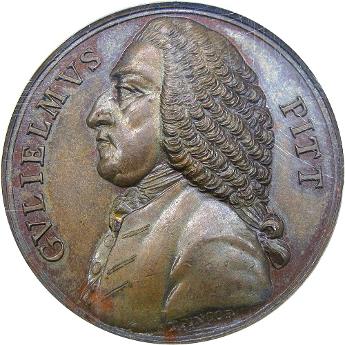
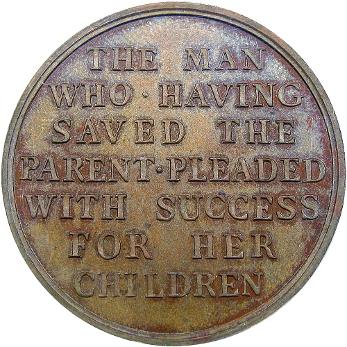
Known Compositions & Estimated Rarity:
Bronze R.5, Brass R.8, Silver R.7
Key Diagnostics:
Large bust - Signed obverse - Lathe-spun rims - Flat, close collar edge
40.0 - 40.3mm, average weight: 37 grams
Gap between GUL and IELMUS
Trimmed R in PARENT
Globular spacer dots; first irregularly shaped, second round
All show die rust at truncation of bust.
DMRC-1A
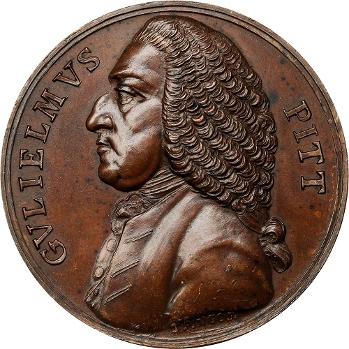
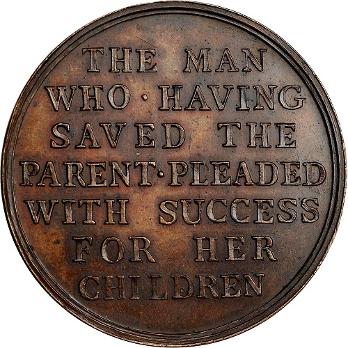
Known Compositions & Estimated Rarity:
BronzeR.7
Key Diagnostics:
Exactly the same as DMRC-1 but:
Shows meandering, hairline die crack from M in MAN, to A in HAVING, to L in PLEADED, to U in SUCCESS, to H in HER.
Diagonal die scratches above MAN and through "D" in "PLEADED"
Struck on 22gram planchet
DMRC-2
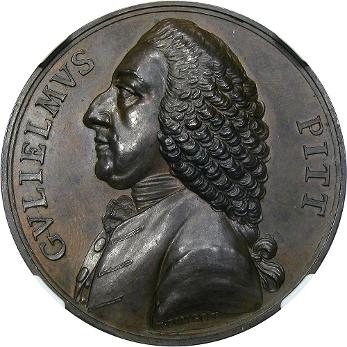
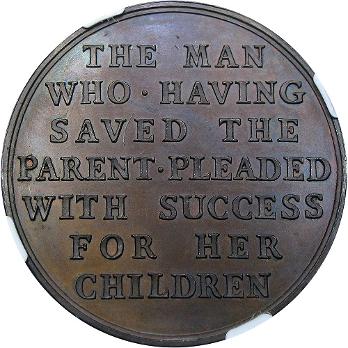
Known Compositions & Estimated Rarity:
Bronze R.5, Silver R.6
Key Diagnostics:
Small bust - Signed obverse - Lathe-spun rims - Flat, close collar edge
40.0 - 40.3mm
Small bust, signed
Dimple on cheek
Cravat pulled away from neck & chin
Raised, double rim, flat edge
Last S in SUCCESS high
Round, globular spacer dots
Die break through GUL on middle to late stages
DMRC-3
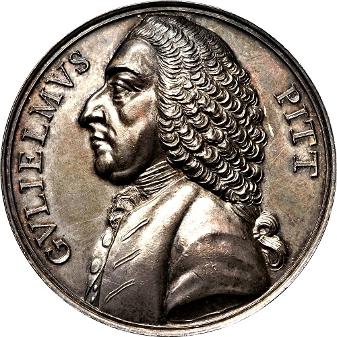
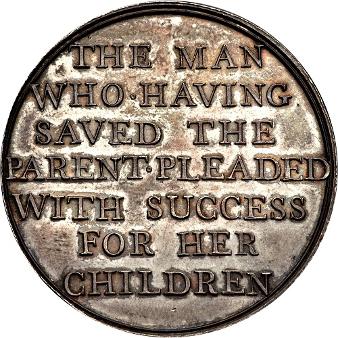
Known Compositions & Estimated Rarity:
Silver R.8
Key Diagnostics:
Small bust - Unsigned obverse - Lathe Spun Rims - Flat, close collaredge
40.2-40.3mm
Tall, narrow, symmetrically machined letter punches with extra large Ws
Reverse lettering merges with rim
Dimpled, round spacer dots
DMRC-3A
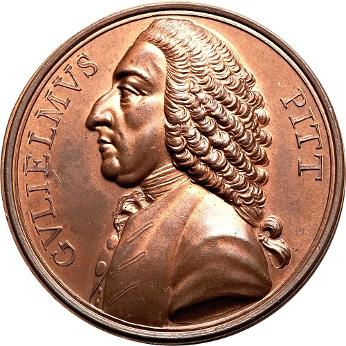
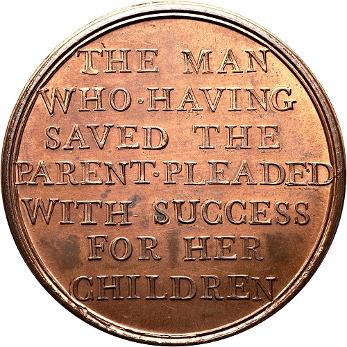
Known Compositions & Estimated Rarity:
Bronze R.4, Gilt Bronze R.7
Key Diagnostics:
Same as DMRC-3 but:
Weakened hair details - False rims - Squeezed edge on oversized planchet
41.0mm - 41.5mm
Die break through second D in PLEADED, and crumbling rims, in later die states
Note: This may prove to be a set of copy dies made from DMRC-3.
DMRC-4
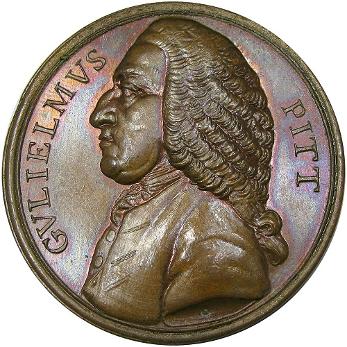
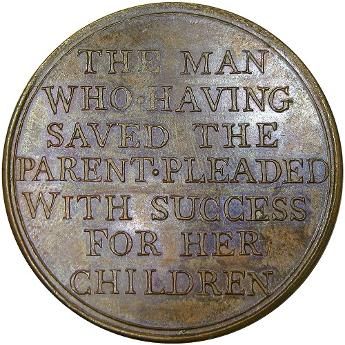
Known Compositions & Estimated Rarity:
Bronze R.8, White Metal R.8, Silver R.8, Over-struck on Silver Crown R.8
Key Diagnostics:
Large bust - Unsigned Obverse - False rims - Squeezed edge on over-sized planchet
41.8mm - 43.0mm
Obverse die a "Cast Copy Die" made from DMRC-1
Reverse die a "Cast Copy Die" of our DMRC-3
Grainy overall texture. Extensive die refinishing and filing to reduce lumps and defects from casting has made letters appear scant and irregular.
Extensive hand re-engraved hair details.
Bibliography
Adams, John W. and Dr. Fernando Chao. Medallic Portraits of Admiral Vernon. Gahanna, OH: Kolbe & Fanning Numismatic Booksellers, 2010.
Anderson, Fred. Crucible of War. New York: Vintage Books, 2000.
Betts, C. Wyllys. American Colonial History Illustrated by Contemporary Medals. New York: Scott Stamp and Coin Company Ltd., 1894.
Bond, William H., and Thomas Hollis. “Letters from Thomas Hollis of Lincoln’s Inn to Andrew Eliot.” Proceedings of the Massachusetts Historical Society 99 (1987): 76–167. http://www.jstor.org/stable/25080979.
Bowers, Q. David. Whitman Encyclopedia of Colonial and Early American Coins. Atlanta: Whitman Publishing, LLC., 2009.
Brown, Lawrence. British Historical Medals, 1760-1960. Volume 1. London: Seaby Publications Ltd., 1980.
Eimer, Christopher. The Pingo Family & Medal Making in 18th-Century Britain. London: British Art Medal Trust, 1998.
______. British Commemorative Medals and Their Values. London: Spink & Son, 2010.
Groh, Edward. A Counterfeit Pitt Medal. The American Numismatic & Archaeological Society of New York City: List of Meetings Held And Papers Read Before The Society Under The Direction of The Committee on Papers And Publications, 1900-1901. P 68-69.
Pitt, William. “In Defense of the Colonies.” William Pitt's speech on the Stamp Act January 14 1766. http://www.let.rug.nl/usa/documents/1751-1775/william-pitts-speech-on-the-stamp-act-january-14-1766.php
Reid, Stuart J. The Graphic, October 19, 1907. Book Review of Von Ruville, Albert, “William Pitt, Early of Chatham.” Translated by H.J. Chayton, M.A.
Photographs of DMRC-3 and DMRC-3A used with permission from Heritage Auctions.
